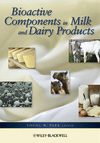Tharp & Young: Hybrid Products
“Hybrids” Offer Novel Product Concepts
There are three classical types of frozen desserts – ice cream (most recently including lower-fat products), sherbet and water ice. About three decades ago a new category was added – frozen yogurt. In a broad sense, frozen yogurt can be considered to represent a “hybrid” product, i.e., created by merging two distinct types of processed dairy foods – yogurt and frozen dessert.
We believe the “hybrid” frozen desserts category can be expanded to include new combinations of frozen desserts and cultured products. We have found that sour cream and cultured buttermilk can be rolled into the frozen dessert category with results similar to what has already been experienced with frozen yogurt. If properly formulated, novel frozen desserts with mild and highly desirable cultured flavor (milder and significantly different than frozen yogurt) are possible.
Additional positive effects could include improvement in water immobilization control, resistance to heat shock and other elements of functionality that might allow ultra-low solids, ultra-high overruns or nutritionally efficacious probiotic cultures, and prebiotic ingredients.
The case for sour cream
Sour cream seems a natural as an ingredient in fat-containing frozen desserts such as full-fat (>10% milk fat), reduced-fat (~7-8% milk fat) and low-fat (~4-5% milk fat) ice cream.
The concept is simple. Sour cream (~18-20% full fat sour cream or ~9-10% light sour cream) can provide all or a significantly high percentage of total milkfat in the frozen dessert. Thus, sour cream or light sour cream could conceptually be up to 50% of any given frozen dessert mix formula. Since sour cream contains only 4-5% MSNF, other sources of MSNF would have to be included, as in conventional frozen desserts, to provide a necessary MSNF functionality.
The quality of sour cream used becomes critical as the amount is increased. Any flavor or functional attributes in the original sour cream will be enhanced (for good or bad) in the final frozen dessert due to freeze concentration. Sour cream can be sourced from a dedicated producer. Or, it is possible to culture cream within the confines of an ice cream plant, similar to what is currently done when making frozen yogurt. Depending on culturing conditions, culture used and other factors, fine control of sour cream flavor can be achieved. A range of flavor profiles would be possible, from a product without added flavoring that features the sour cream flavor to one in which the cultured flavor background enhances that of added flavorings and inclusions to produce a novel profile not otherwise attainable.
In any case, the intensity of cultured flavor can be made more or less predominant as desired. Finally, related to functionality, water immobilization can be managed by selection of novel polysaccharide producing cultures. The inclusion of a buffering system is useful in managing the effects of the sour cream’s acidity on protein stability.
Given the current popularity of co-branding (e.g., branded ice cream with branded candies), novel co-branding opportunities between a branded ice cream and a branded sour cream are possible.
The case for buttermilk
Similar to cultured cream, cultured buttermilk (cultured skimmed or partially skimmed milks) offers significant new product opportunities. However, lower milkfat and lower MSNF contents, and typical intense cultured product flavor of cultured buttermilk, limit the amount of cultured buttermilk that might be considered in most frozen dessert formats.
Having said this, it is wholly possible to consider cultured buttermilk to be a source of all or part of the milk solids in sherbet-like products. The acidity of the buttermilk and its cultured flavor are near perfect for fruit flavor considerations without adding additional acid to the mix. As with using sour cream, few changes in the amount, type or quality of flavoring are necessary.
From a regulatory perspective, there is a question as to whether “hybrid” products that use cultured dairy products do or do not conform to the requirements of their respective standards of identity. In either case, other “hybrid” opportunities might include frozen kefir and frozen cultured acidophilus.
Given all this related to novel sensory, functional and nutritional attributes, it would seem that creation of “hybrid” frozen desserts may be ready for expansion. If you’re ready, we’re ready with approaches, formulations and guidelines.
Details and samples of the “hybrid” frozen dessert concept, developed in cooperation with FMC Hydrocolloids, were presented at IDFA’s Ice Cream Technology Conference last month.
For more on the concept and other new product opportunities, join Dr. Bruce Tharp and Dr. Steven Young at “Tharp & Young On Ice Cream,” Dec. 1-3, 2010, in Las Vegas. Details, including registration information, are available at www.onicecream.com, or call 610/975-4424 or 281/782-4536.
There are three classical types of frozen desserts – ice cream (most recently including lower-fat products), sherbet and water ice. About three decades ago a new category was added – frozen yogurt. In a broad sense, frozen yogurt can be considered to represent a “hybrid” product, i.e., created by merging two distinct types of processed dairy foods – yogurt and frozen dessert.
We believe the “hybrid” frozen desserts category can be expanded to include new combinations of frozen desserts and cultured products. We have found that sour cream and cultured buttermilk can be rolled into the frozen dessert category with results similar to what has already been experienced with frozen yogurt. If properly formulated, novel frozen desserts with mild and highly desirable cultured flavor (milder and significantly different than frozen yogurt) are possible.
Additional positive effects could include improvement in water immobilization control, resistance to heat shock and other elements of functionality that might allow ultra-low solids, ultra-high overruns or nutritionally efficacious probiotic cultures, and prebiotic ingredients.
The case for sour cream
Sour cream seems a natural as an ingredient in fat-containing frozen desserts such as full-fat (>10% milk fat), reduced-fat (~7-8% milk fat) and low-fat (~4-5% milk fat) ice cream.
The concept is simple. Sour cream (~18-20% full fat sour cream or ~9-10% light sour cream) can provide all or a significantly high percentage of total milkfat in the frozen dessert. Thus, sour cream or light sour cream could conceptually be up to 50% of any given frozen dessert mix formula. Since sour cream contains only 4-5% MSNF, other sources of MSNF would have to be included, as in conventional frozen desserts, to provide a necessary MSNF functionality.
The quality of sour cream used becomes critical as the amount is increased. Any flavor or functional attributes in the original sour cream will be enhanced (for good or bad) in the final frozen dessert due to freeze concentration. Sour cream can be sourced from a dedicated producer. Or, it is possible to culture cream within the confines of an ice cream plant, similar to what is currently done when making frozen yogurt. Depending on culturing conditions, culture used and other factors, fine control of sour cream flavor can be achieved. A range of flavor profiles would be possible, from a product without added flavoring that features the sour cream flavor to one in which the cultured flavor background enhances that of added flavorings and inclusions to produce a novel profile not otherwise attainable.
In any case, the intensity of cultured flavor can be made more or less predominant as desired. Finally, related to functionality, water immobilization can be managed by selection of novel polysaccharide producing cultures. The inclusion of a buffering system is useful in managing the effects of the sour cream’s acidity on protein stability.
Given the current popularity of co-branding (e.g., branded ice cream with branded candies), novel co-branding opportunities between a branded ice cream and a branded sour cream are possible.
The case for buttermilk
Similar to cultured cream, cultured buttermilk (cultured skimmed or partially skimmed milks) offers significant new product opportunities. However, lower milkfat and lower MSNF contents, and typical intense cultured product flavor of cultured buttermilk, limit the amount of cultured buttermilk that might be considered in most frozen dessert formats.
Having said this, it is wholly possible to consider cultured buttermilk to be a source of all or part of the milk solids in sherbet-like products. The acidity of the buttermilk and its cultured flavor are near perfect for fruit flavor considerations without adding additional acid to the mix. As with using sour cream, few changes in the amount, type or quality of flavoring are necessary.
From a regulatory perspective, there is a question as to whether “hybrid” products that use cultured dairy products do or do not conform to the requirements of their respective standards of identity. In either case, other “hybrid” opportunities might include frozen kefir and frozen cultured acidophilus.
Given all this related to novel sensory, functional and nutritional attributes, it would seem that creation of “hybrid” frozen desserts may be ready for expansion. If you’re ready, we’re ready with approaches, formulations and guidelines.
Details and samples of the “hybrid” frozen dessert concept, developed in cooperation with FMC Hydrocolloids, were presented at IDFA’s Ice Cream Technology Conference last month.
For more on the concept and other new product opportunities, join Dr. Bruce Tharp and Dr. Steven Young at “Tharp & Young On Ice Cream,” Dec. 1-3, 2010, in Las Vegas. Details, including registration information, are available at www.onicecream.com, or call 610/975-4424 or 281/782-4536.
Looking for a reprint of this article?
From high-res PDFs to custom plaques, order your copy today!







